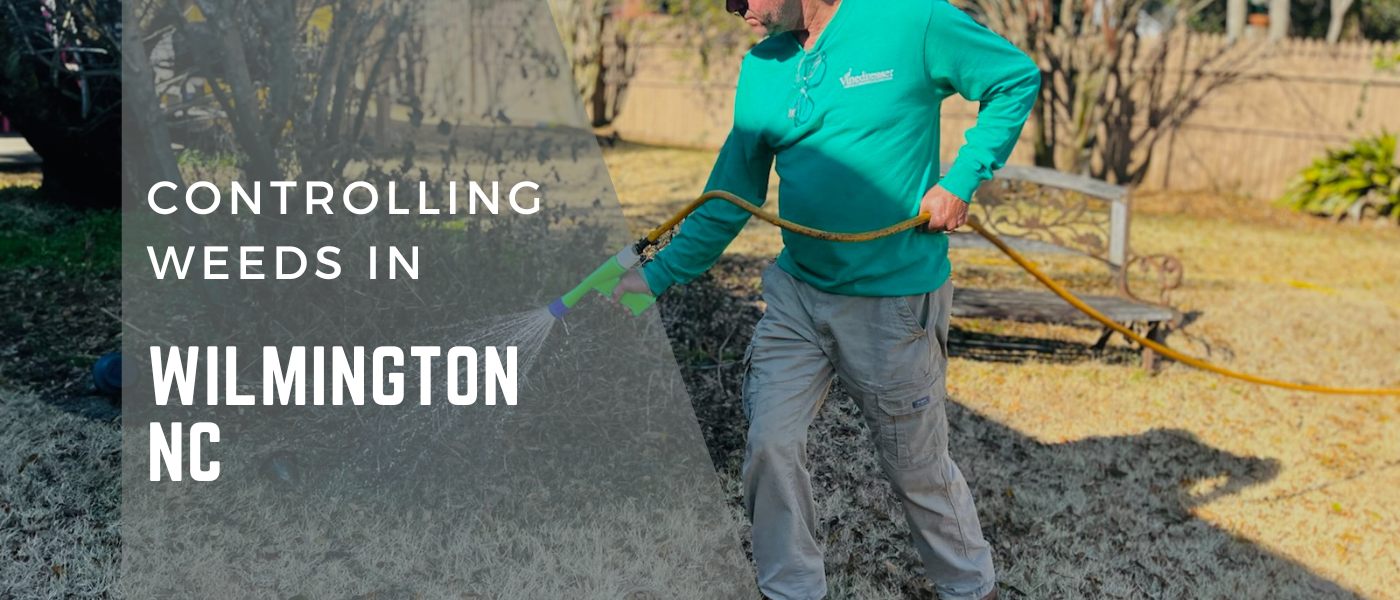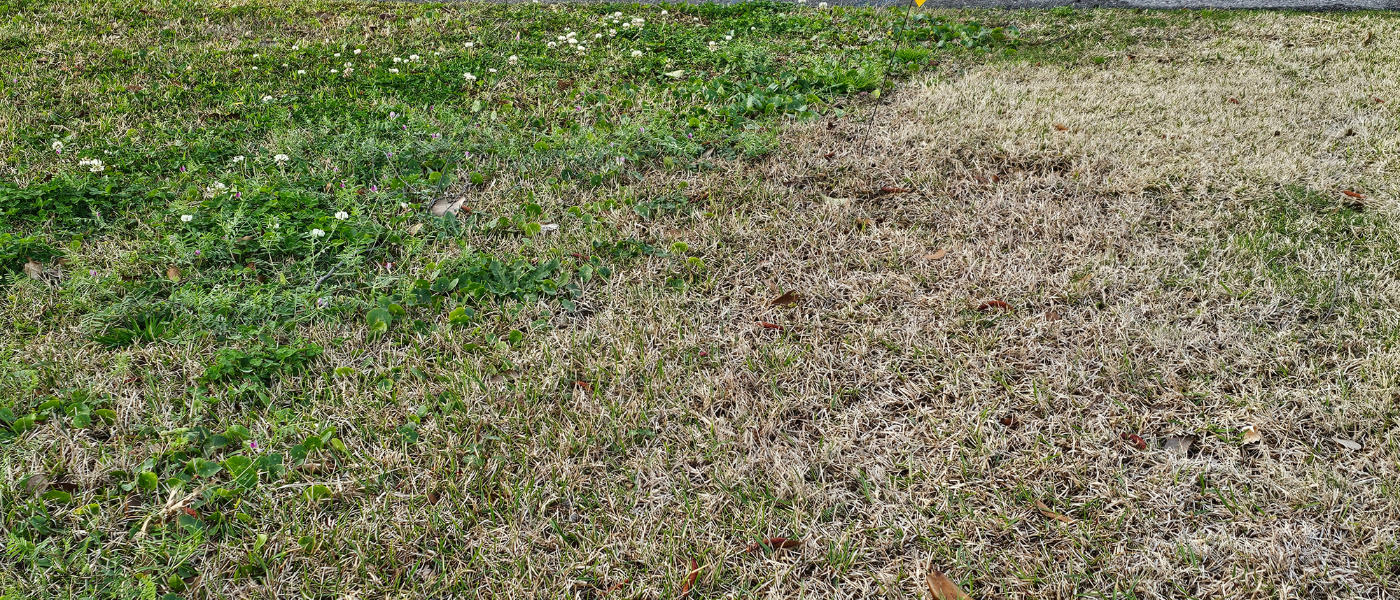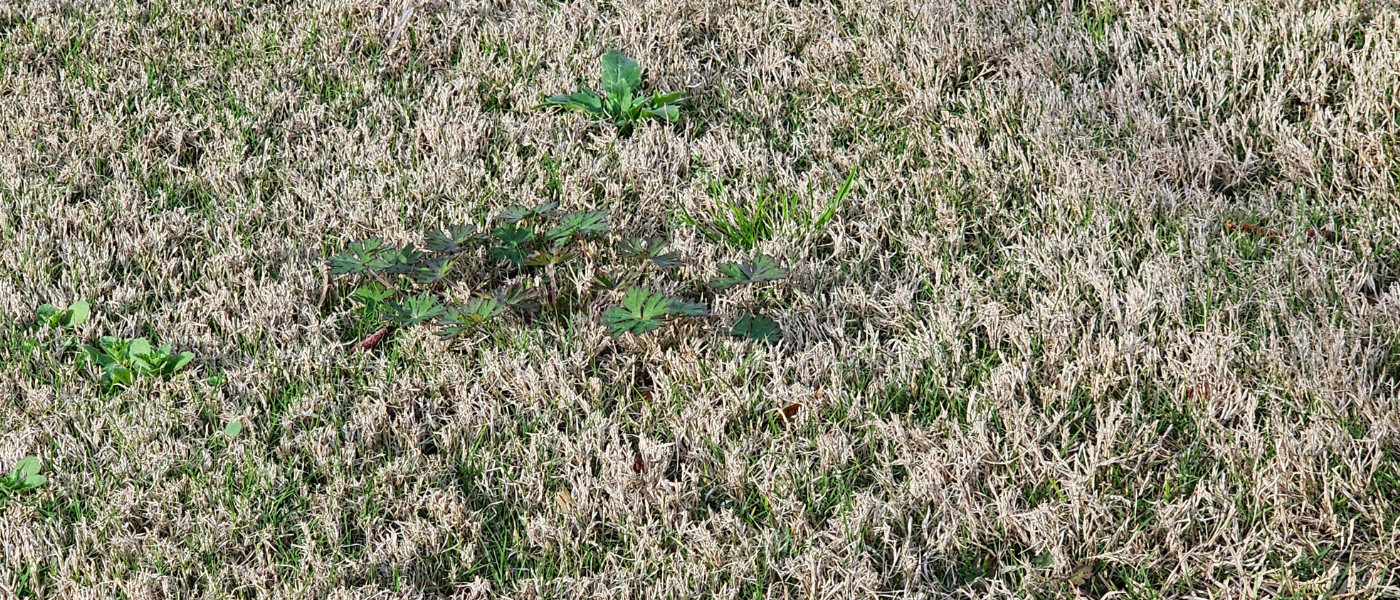
Controlling Weeds in Wilmington, NC: A Complete Guide
In this guide on controlling weeds we dive into common weeds, strategies to control them and common problems.
Welcome to our comprehensive guide to controlling weeds and maintaining a beautiful lawn in Wilmington, NC! Whether you’re a seasoned gardener or a beginner, this guide is packed with essential tips and strategies to help you achieve that perfect green turf despite the common challenges.
Section | Description |
| Weed Categorization | Types of weeds and their growth patterns. |
| Common Lawn Weeds | Tackling prevalent weeds in Wilmington lawns. |
| Mowing Strategies | Effective mowing techniques for weed control. |
| Sunlight & Water | Essential elements for a healthy lawn. |
| Herbicide Use | Selecting and applying herbicides properly. |
| Expert Advice | Professional tips and resources. |
| Common Weed Problems | Dealing with the four most common lawn weeds. |
Weed Categorization
Weeds in your lawn can be categorized as either warm-season or cool-season and as annuals or perennials. This categorization is crucial in formulating an effective weed control strategy.
- Warm season: weeds thrive in the summer heat.
- Cool-season: weeds prefer the cooler temperatures of spring and fall.
- Annual weeds: complete their life cycle in one year, spreading rapidly.
- Perennials: on the other hand, return year after year, making them more challenging to control.
Understanding these categories allows you to anticipate and respond effectively to different weed types throughout the year.
Common Lawn Weeds
In Wilmington, NC, maintaining a lush, vibrant lawn involves combating a variety of common weeds. These unwelcome plants can be broadly categorized into two groups: warm-season annuals and tough perennial weeds. Here’s a closer look at some of the most prevalent weeds that homeowners in Wilmington might encounter:
Warm-Season Annuals:
- Crabgrass: Known for its rapid growth in warm conditions, crabgrass spreads quickly and can crowd out healthy grass.
- Goosegrass: Similar to crabgrass, goosegrass thrives in compacted soil and high-temperature environments.
- Spurge: Easily recognizable by its low, spreading growth and small, oval leaves, spurge is a common sight in the summer months.
- Pigweed: Known for its fast growth and drought resistance, pigweed can quickly become a dense, problematic weed.
- Barnyard Grass: Without the characteristic crabgrass patches, barnyard grass can still crowd out healthy turf with its tall, leafy growth.
- Sandbur: This weed produces spiny burs that can stick to clothing and pets, making lawn activities uncomfortable.
Tough Perennial Weeds:
- Dallisgrass: This perennial weed is particularly challenging due to its clumpy growth and resilience. It’s known for its ability to spread rapidly and create unsightly patches.
- Florida Betony: Often called “rattlesnake weed” because of its tubular, white roots, Florida Betony is a hardy perennial that can be difficult to eradicate once established.
- Nutsedge: Characterized by its tall, grass-like leaves, nutsedge is a persistent weed that often indicates overly moist soil conditions.
- Clover: Trifoliate leaves and white flowers are the hallmarks of clover, a weed that can dominate in nitrogen-poor soil.
- Wild Violet: These low-growing plants with heart-shaped leaves and purple flowers can overtake a lawn if unchecked.
- Henbit: With distinctive purple flowers, henbit can spread rapidly in spring, exploiting thin, weak areas in the lawn.
Addressing the issue of common lawn weeds in Wilmington requires a strategic approach, including regular lawn maintenance, proper identification, and targeted treatment methods. By understanding the specific challenges posed by these weeds, homeowners can take effective steps to preserve the health and appearance of their lawns.

Mowing Strategies: Your Lawn’s Best Defense
Mowing your lawn is not just about keeping it tidy; it’s a key strategy in fighting weeds. Here’s how you can use mowing to your advantage:
Know Your Grass
- Type Matters: Different grass types need different mowing heights. For instance, Centipede grass, popular in Wilmington, thrives at a height of 1-1.5 inches.
Mowing Height Matters
- Shade the Soil: Mowing at the right height lets your grass shade the soil, preventing weed seeds from getting the sunlight they need to germinate.
- Ideal Height: Keeping grass at its preferred height makes it stronger and more competitive against weeds.
The Power of Frequent Mowing
- Seed Head Removal: Regular mowing gets rid of weed seed heads, cutting down on their spread.
- Consistency is Key: Mowing often keeps your lawn healthy and prevents weeds from taking over.
Effective Mowing Techniques
- Stay Consistent: Avoid letting the grass get too long between mowings to prevent stress and weed invasion.
- Mix It Up: Change your mowing pattern regularly to avoid ruts and ensure even growth and cutting.
Learn From the Pros
Effective mowing is essential for controlling weeds and maintaining a lush lawn. Learn the best mowing techniques for your turf type at Vinedresser’s Lawn Mowing Service.
By understanding the specifics of your lawn’s grass type and adhering to these mowing strategies, you can significantly improve your lawn’s health and appearance. Mowing isn’t just about cutting grass; it’s about cultivating a thriving environment that naturally resists weeds. For tailored advice and expert lawn care services, reach out to Vinedresser’s Lawn Mowing Service. Together, we’ll make your lawn the best it can be.
Harnessing Sunlight and Water for Weed Control
Believe it or not, the right balance of sunlight and water doesn’t just contribute to a lush lawn; it’s also a powerful ally in your quest to control weeds. By strategically managing these essential elements, you can create an environment where your grass thrives and weeds struggle to take hold. Here’s how to leverage sunlight and water in the battle against weeds:
Sunlight: Your Lawn’s Best Friend
- Optimal Exposure: Grass needs about 8 hours of direct sunlight daily to grow thick and strong, crowding out potential weeds. If parts of your lawn are too shady and become a haven for weeds, consider planting shade-tolerant grass varieties. These types can compete better under trees or in other low-light areas, reducing the opportunity for weeds to establish.
- Adapting to Shade: In heavily shaded areas where grass struggles, think beyond traditional turf. Groundcovers or shade-loving plants can provide a beautiful, low-maintenance alternative, minimizing bare spots where weeds often sprout.
Water: Deeply and Wisely
- Promote Deep Roots: A watering regimen that soaks the soil deeply but infrequently encourages your grass to develop deep roots. Deep-rooted grass is more drought-resistant and can access water and nutrients that shallow-rooted weeds cannot, giving it a competitive edge.
- Spot Drought Stress Early: Weeds often thrive in stressed, under-watered lawns. By recognizing signs of drought stress (like wilting, a blue-gray tint, and persistent footprints), you can take timely action to hydrate your lawn, bolstering its defense against weed invasion.
Implementing Effective Strategies
- Monitor and Adjust: Keep an eye on your lawn’s sun exposure and adjust your landscaping or choice of grass accordingly. This proactive approach can prevent weed problems before they start.
- Smart Watering: Aim for early morning watering to reduce evaporation and ensure the water penetrates deeply. This schedule supports healthy grass growth and makes it tough for weeds to compete.
- Stay Vigilant: Early signs of drought stress are also early signs of potential weed issues. By acting quickly to address these signs, you’re not just saving your lawn from drought; you’re keeping it from becoming a weed magnet.
By mastering the management of sunlight and water, you’re not just caring for your lawn; you’re setting up a natural barrier against weeds. A lawn that’s healthy, resilient, and properly hydrated is your best defense against the encroachment of unwanted plants. Remember, every step you take to optimize these conditions is a step toward a weed-free lawn. For more advice on weed control and lawn care, don’t hesitate to consult with lawn care professionals. Together, we can achieve a beautiful, vibrant, and weed-resistant lawn.

Smart Herbicide Use for Controlling Weeds in Wilmington NC
Herbicides, when used wisely, can play a pivotal role in your lawn care arsenal, helping you win the battle against stubborn weeds. However, the key to harnessing their full power lies in using them correctly and responsibly. Here’s how you can make herbicides work for you, not against you:
Choosing the Right Herbicide
- Know Your Lawn: The effectiveness of a herbicide greatly depends on the types of weeds you’re targeting and the kind of grass you have. It’s not a one-size-fits-all situation.
Selective vs. Non-Selective:
- Selective Herbicides: These are your precision tools. Designed to target specific weeds, they leave your grass healthy and unharmed. Perfect for when you’re dealing with invasive species but want to keep the rest of your lawn intact.
- Non-Selective Herbicides: The heavy artillery. These formulas don’t discriminate, wiping out all vegetation they come into contact with. Use them for total vegetation control or in areas where you plan to start anew.
Following Label Instructions
- Safety First: Always, and we mean always, follow the label instructions. They’re there to ensure that you use the product safely and effectively.
- Application Dos and Don’ts: The label will guide you on how much to apply, when to apply, and the necessary precautions to take. This information is crucial for protecting not only your lawn but also yourself and the environment.
Timing Is Everything
- Seasonal Application: Some herbicides are seasonal players, offering the best results when applied at certain times of the year. Whether it’s pre-emergent herbicides in early spring or post-emergent formulas during active growth periods, timing their application can make a world of difference.
- Growth Stages: Understanding the growth stage of the weed can also dictate the herbicide’s effectiveness. Applying at the right growth stage ensures that the weeds absorb the herbicide for maximum impact.
By selecting the appropriate herbicide, following the label instructions to the letter, and applying it at the optimal time, you’re setting the stage for a weed-free lawn. Herbicides, when used as part of a broader lawn care strategy, can significantly reduce weed problems and help maintain the health and beauty of your outdoor space.
Remember, the goal is not just to eliminate weeds but to do so in a way that promotes a vibrant, healthy lawn for years to come. For personalized advice and lawn care solutions, consider consulting with lawn care professionals who can provide guidance tailored to your lawn’s specific needs.
Choosing a suitable herbicide is critical to effective weed control. Learn more about selecting and applying herbicides at Vinedresser’s Weed Control Services.
Expert Advice: Leveraging NC State Extension TurfFiles
When it comes to controlling weeds in Wilmington, you’re not alone. The NC State Extension TurfFiles is your go-to resource, packed with expert knowledge on weed identification and control strategies. Whether you’re dealing with a stubborn patch of Dallisgrass or an invasion of Florida Betony, this online resource has you covered. Here’s how TurfFiles can become a valuable ally in your quest for a pristine lawn:
Comprehensive Weed Identification
- Detailed Descriptions: TurfFiles provides in-depth information on a wide array of weeds, helping you pinpoint exactly what you’re up against.
- Visual Guides: With images and descriptions, identifying the unwelcome guests in your lawn becomes much easier.
Recommended Control Methods
- Tailored Strategies: Find specific advice on tackling different types of weeds, from pre-emergence strategies to post-emergence attacks.
- Cultural Practices: Learn how proper lawn care practices can help prevent weed problems before they start.
Herbicide Recommendations
- Selective Solutions: Discover which herbicides are effective against particular weeds while being safe for your type of grass.
- Application Tips: Get guidance on how to apply herbicides safely and effectively, ensuring the best possible results.
The NC State Extension TurfFiles is more than just a website; it’s a comprehensive guide designed to help homeowners like you maintain healthy, vibrant lawns in Wilmington. By combining this expert advice with regular lawn care practices, you can stay one step ahead of weed issues and enjoy a beautiful outdoor space.
Remember, while online resources are incredibly helpful, sometimes there’s no substitute for professional advice tailored to your lawn’s unique conditions. Don’t hesitate to reach out to lawn care experts for personalized recommendations and solutions. Together, with the right knowledge and expert support, you can achieve the lush, weed-free lawn you’ve always wanted.
The 4 Most Common Weed Problems in Lawns
Weeds are more than eyesores; they’re resilient plants requiring strategic control. Let’s break down the four most common types in your Wilmington lawn.
- Broadleaf Weeds: These weeds, including dandelions and clover, have wide leaves and are very common. They often invade lawns that are undernourished or thinly grown.
- Sedge Weeds: Resembling grass in appearance, sedges thrive in wet, poorly drained areas. Their control often involves improving drainage and soil conditions.
- Rush Weeds: These weeds are usually found in wet, compacted soils. Aeration and proper soil management are key to controlling rush weeds.
- Grassy Weeds: Weeds like crabgrass and annual bluegrass are common in lawns. Pre-emergent herbicides applied in early spring can be effective in controlling these weeds.
Final Thoughts
Controlling weeds in Wilmington, NC, involves understanding your lawn’s specific challenges. Every aspect plays a crucial role, from weed identification to implementing proper mowing, watering, and herbicide application techniques. With this guide and professional resources like Vinedresser Lawsn and Landscape, you can transform your lawn into a beautiful, healthy outdoor space.
For comprehensive lawn care services and expert advice, visit Vinedresser Lawn & Landscape..
Remember, a well-maintained lawn is not just a matter of pride; it contributes to your home’s overall beauty and health.
